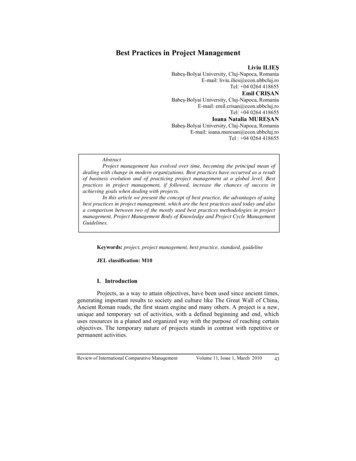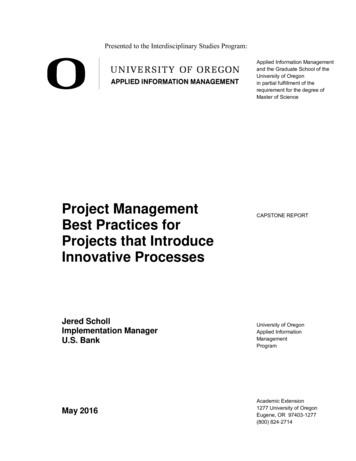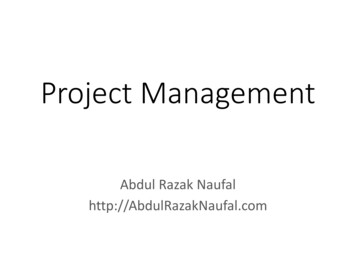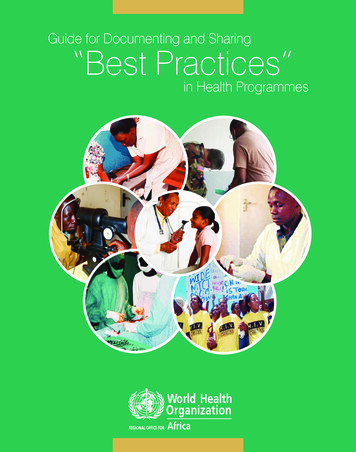
Transcription
Best Practices in Project ManagementLiviu ILIEŞBabeş-Bolyai University, Cluj-Napoca, RomaniaE-mail: liviu.ilies@econ.ubbcluj.roTel: 04 0264 418655Emil CRIŞANBabeş-Bolyai University, Cluj-Napoca, RomaniaE-mail: emil.crisan@econ.ubbcluj.roTel: 04 0264 418655Ioana Natalia MUREŞANBabeş-Bolyai University, Cluj-Napoca, RomaniaE-mail: ioana.muresan@econ.ubbcluj.roTel : 04 0264 418655AbstractProject management has evolved over time, becoming the principal mean ofdealing with change in modern organizations. Best practices have occurred as a resultof business evolution and of practicing project management at a global level. Bestpractices in project management, if followed, increase the chances of success inachieving goals when dealing with projects.In this article we present the concept of best practice, the advantages of usingbest practices in project management, which are the best practices used today and alsoa comparison between two of the mostly used best practices methodologies in projectmanagement, Project Management Body of Knowledge and Project Cycle ManagementGuidelines.Keywords: project, project management, best practice, standard, guidelineJEL classification: M10I. IntroductionProjects, as a way to attain objectives, have been used since ancient times,generating important results to society and culture like The Great Wall of China,Ancient Roman roads, the first steam engine and many others. A project is a new,unique and temporary set of activities, with a defined beginning and end, whichuses resources in a planed and organized way with the purpose of reaching certainobjectives. The temporary nature of projects stands in contrast with repetitive orpermanent activities.Review of International Comparative ManagementVolume 11, Issue 1, March 201043
The characteristics of a project require a specific type of management.Project management is the application of knowledge skills, tools and techniques toproject activities. Project management is accomplished through the application andintegration of the project management processes of initiating, planning, executing,monitoring and controlling, and closing (Project Management Body of Knowledge,2004, pp. 38). Project management is recognized to be the key enabler of businesschange and a vital contributor to future business success (Whitty, Maylor, 2009,pp. 304).Project management has evolved over time to a sophisticated and complexprocess, becoming the principal mean of dealing with change in modernorganizations. As projects developed and knowledge was gained in this field,standards have occurred. Organizations and project management associations allover the world started to develop and follow these standards in order to optimizethe project management activity.In this article we are presenting the following issues regarding bestpractices in project management:1. The concepts: best practice, guideline and international standard in projectmanagement;2. Advantages of using best practices in project management;3. Best practices methodologies used today in project management;4. Comparison between two of the mostly used best practices methodologies inproject management.II. Best practices, guidelines or international standards in projectmanagement?A best practice is a technique, method, or process that is believed to bemore efficient and effective in achieving a goal than any other techniques, methodsand processes, when applied to a particular condition or circumstance.Best practice is based on experience and is used to describe the process ofdeveloping and following a standard way of doing things. In project management,best practice is a general term that includes: Guidelines; International standards.Both standards and guidelines are looking to improve project management.In practice most project managers do not make any difference between the twoconcepts, reason why we decided to write this article about both internationalstandards and guidelines in project management, as methods that can contribute togoal achievement when dealing with projects, as best practices.Whereas standards are expected to be objective, definitive and robust,guidelines issued by professional bodies are open to interpretation (Ahlemann,Teuteberg, Vogelsang, 2009, pp. 293). But, standards issued by specializedorganizations are usually based on best practices and guidelines given byprofessional bodies. However, sometimes guidelines become standards, such as44Volume 11, Issue 1, March 2010Review of International Comparative Management
PMI’s project Management Body of Knowledge, which became an ANSI norm in2004 (Ahlemann, Teuteberg, Vogelsang, 2009, pp. 293).III. Advantages of using best practices in project managementHistorically, in the 1950s project management was first recognized as aseparate management method, different from other management methodsemployed in government or corporate business (Nielsen, 2006, pp. 61).Nowadays, project management has reached a global level, the methods ofproject management evolving in guidelines and international standards, generallyaccepted and employed. The attributes for global standards are: relevant, useful,acceptable, applicable, meaningful, used and valued, according to The GlobalWorking Group (Nielsen, 2006, pp. 62, www.aipm.com).The advantages of using international standards and guidelines in projectmanagement are (Figure 1):a. Transfer of knowledge: Project management is the most widely foundcause for failure to meet project objectives and goals (Nielsen, 2006, pp. 61). Astandardized approach of project management comes to support the projectmanager when dealing with multiple projects with different competency needs,reducing the management risk and maximizing the achievement of goals;b. Better communication: Communication is a key element in projectmanagement, being a major factor that influences the success or the failure of aproject. Standards are also expected to help harmonize divergent terminology anddifferent understandings of processes and methods (Ahlemann, Teuteberg,Vogelsang, 2009, pp. 292);c. Time and cost savings: Projects are time dependent, so timemanagement is part of project management. It's only when you measure time whenyou see how precious resource is spent reinventing the wheel (Ford, 2008, pp. 31).Best practices in project management bring the benefit of saving time and moneyin dealing with projects, goals that all project based organizations must strivetoward, particularly in time of economic recession;d. Better process quality: Standards and guidelines improve quality byreducing failure and maximizing the achievement of goals;e. Better team work: The team will be better organized, the tasks will beclearly defined and the team work will be more efficient;f. Better position on the market: Applying international standards and bestpractices in project management contributes to a better position of the business onthe market, as it will prove high project management competence to allstakeholders;g. An international approach of labor: A standard approach of knowledge,competence and processes facilitates working in an international environment;h. Better monitoring and controlling of projects: In a global economy,standards are needed to improve the efficiency of monitoring and controllinginternational projects;Review of International Comparative ManagementVolume 11, Issue 1, March 201045
i.A more efficient and objective audit: Standards are essential in auditingprojects. Following international standards will increase the efficiency of theauditing process.Figure 1 The advantages of using best practices in project managementSince projects are generally perceived to be unique, it cannot be expectedthat the same set of processes and methods will foster the success of each andevery project (Ahlemann, Teuteberg, Vogelsang, 2009, pp. 294). Best practices inproject management contribute to the achievement of goals, but project managersneed to determine which project management methods can be generally appliedand which are appropriate in specific situations. Project managers also need to beable to adapt the international standard to the cultural differences which appear indifferent areas or countries.IV. Best practices methodologies used today in project managementA wide range of best practices is currently available for projectmanagement, issued by diverse organizational bodies, such as the large nationaland international official standard-giving organizations (e.g. ISO, ANSI), project46Volume 11, Issue 1, March 2010Review of International Comparative Management
management associations all over the world and other associations that promoteindustry-specific standards (Ahlemann, Teuteberg, Vogelsang, 2009, pp. 292).The organizational bodies that have the most significant activity indeveloping project management are: American National Standardization Institute(ANSI), the International Standardization Institute (ISO), the Project ManagementInstitute (PMI), the International Project Management Association (IPMA).Due to this diversity, the selection and application of project managementguidelines and standards is a complex problem for organizations. The challenge isto identify a guideline or standard that: Is widely used among project partners and stakeholders so that aconsensus can be established; Is applicable for this type of organization and the type of projects sothat it can be implemented efficiently; Unfolds real benefits for the organization so that it is effective(Ahlemann, Teuteberg, Vogelsang, 2009, pp. 292).For a best practice to be really beneficial it is important that the group ofstakeholders accepting it to be as large as possible. Here, an important role isplayed by the leader who should be able to send powerful messages to thestakeholders (Nastase, 2009, pp. 1036). This may be explained by the networkeffect theory, since each additional stakeholder applying a standard or guidelinemakes it more useful for the rest of the community (Ahlemann, Teuteberg,Vogelsang, 2009, pp. 293).In the following table we are presenting some of the project managementstandards and guidelines that are better known and mostly used.Project Management Standards and GuidelinesTable 1InternationalStandard/GuidelinesICBISO 10006OPM3PMBOKDescriptionInternational Competence Baseline issued by theInternational Project Management Association(IPMA)Standard for quality management in projectmanagement issued by the International StandardsOrganization (ISO)Organizational Project Management Maturity Modelissued by the Project Management Institute (PMI)PMBOK Guide to the Project Management Body ofKnowledge issued by the Project ManagementInstitute (PMI); at the same time ANSI standard forproject management (an American national standard)Review of International Comparative ManagementVolume 11, Issue 1, March 201047
ptionProject management standard developed and issuedby the British Office of Government Commerce(GOC)A Guidebook of Project & Program Management forEnterprise Innovation issued by ENNAProject Cycle Management Guidelines issued by theEuropean CommissionWe decided to make a comparison between the Project Management Bodyof Knowledge (PMBOK) and the Project Cycle Management (PCM), as both arewell-known guidelines and the first one has also become an international standard.a.The American point of view - PMBOKThe Project Management Institute (PMI) published the PMBOK Guide forthe first time in 1987, in an attempt to standardize generally accepted projectmanagement information and practices. The PMBOK Guide was edited for the 4thtime in 2008 and it is now one of the most widely used standards in projectmanagement.The Project Management Body of Knowledge (PMBOK) is a collection ofprocesses and knowledge areas generally accepted as best practice within theproject management discipline. The PMBOK Guide it is also an internationallyrecognized standard that provides the fundamentals of project management as theyapply to a wide range of projects. Specialized standards were developed as anextension to PMBOK, in order to suit special industries for example PMBOKConstruction Extension and PMBOK Government extension.b.The European point of view - PCMIn 1992, the European Commission (EC) adopted the “Project CycleManagement” (PCM), a set of project design and management tools based on theLogical Framework method of analysis. The manual was subsequently updated in2001 and 2004.The PCM Guidelines are targeted at EC Project Managers, their officialpartners in third countries, and other stakeholders such as non-state bodies andconsultants who are engaged in the design and delivery of EC supported projectsand programs (PCM Guidelines, 2004, p. 3).The comparison will focus on the following elements:1. Publication: PMBOK was first published six years before theproduction of PCM in 1993. The last edition of the guideline waspublished in 2008 for PMBOK and in 2004 for PCM.2. Status (guideline vs. standard): Both PMBOK and PCM are guidelines,but the first one also became an ANSI norm in 2004.48Volume 11, Issue 1, March 2010Review of International Comparative Management
3. Utilization: PMBOK is utilized in United States of America and inorganizations all over the world, being the most widely used standard inproject management. PCM is used especially in Europe, being theguideline adopted by the European Commission.4. Approach of project management methods: The PMBOK Guide isprocess-based, as the PCM Guidelines is based on the LogicalFramework method of analysis.Content: PMBOK is general and it can be adapted to any organization, onthe other hand PCM is specific, focused on the European Commission’sDevelopment Policy. PMBOK identifies five process groups when dealing with aproject and PCM identifies five phases. There can be indentified some commonelement between the two guidelines, as planning is similar to programming,executing to implementation and controlling and monitoring is similar toevaluation and audit.PMBOK vs. PCMTable 2PMBOKFirst publication:1987 - The Project ManagementInstitute1 (PMI) published the PMBOKGuide;Number of editions published:Four editions - The English-languagePMBOK Guide - Fourth Edition wasreleased on the 31st of December 2008;Status:Guideline and at the same time an ANSIstandard for project management;Utilization:United Stated of America andorganizations from all over the world;Approach:The PMBOK Guide is process-based,meaning it describes work as beingaccomplished by processes;1PCMFirst publication:1992 - The European Commission (EC)adopted the “Project CycleManagement” (PCM). The first PCMmanual was produced in 1993;Number of editions published:Three editions – The third edition PCM‘Guidelines’ was released in 2004;Status:Guideline;Utilization:European Union and third countries, asPCM is a guideline used especially bythe European Commission;Approach:PCM is based on the LogicalFramework method of analysis;The Project Management Institute was founded in 1969, in United States of America and isrecognized to be the largest project management professional organization, with a world wideactivity in this field.Review of International Comparative ManagementVolume 11, Issue 1, March 201049
PMBOKContent:POBOK Guide describes processes interms of: Inputs; Tools and Techniques; Outputs.The PMBOK Guide recognizes 44processes organized in five basicprocess groups and nine knowledgeareas.The five process groups are: Initiating,Planning, Executing, Controlling andMonitoring, and Closing.The nine knowledge areas are: ProjectIntegration Management, Project ScopeManagement, Project TimeManagement, Project CostManagement, Project QualityManagement, Project Human ResourceManagement, Project CommunicationsManagement, Project RiskManagement, and Project ProcurementManagement.PCMContent:The PCM Guideline is structured in twoparts:Part 1: The EC Development Policy; The role of projects as an EC aiddelivery mechanism; PCM operational guidelines - Thissection provides an overview ofProject Cycle Management and anoperational description of eachstage of the project cycle.Part 2: A detailed description of theLogical Framework Approach andreferences to a number of othercomplimentary tools used to supportstructured analysis and informeddecision-making at various stages ofthe project management cycle.The PCM has five phases:Programming, Identification,Formulation, Implementation,Evaluation and Audit.ConclusionsThe evolution of project management has determined the appearance ofguidelines and standards in this field. We consider both guidelines and standards tobe best practices, based on experience. In this article, we presented the advantagesof using best practice methodologies in project management.In this article, we also presented the best practices methodologies usedtoday in project management, focusing on two of the mostly used guidelines inproject management - PMBOK and PCM Guidelines.The general nature of PMBOK makes the guideline applicable in all typesof organizations, from all over the world. On the other hand, the PCM Guidelinesis adapted to the European Commission’s Development Policy and probably betterin this specific case.As a conclusion to the comparison, we think that PCM will probably neverbecome an international standard, as PMBOK is, because of its specific nature.Although it cannot be said which best practice is better, we consider thatthe number of stakeholders accepting it should be the criteria when choosing the50Volume 11, Issue 1, March 2010Review of International Comparative Management
guideline or standard to be applied. As a future research in this field, we willanalyze the process of choosing a standard in organizations from all over the world.References1. Ahlemann, F.; Teuteberg, F.; Vogelsang, K., (2009) “Project managementstandards – Diffusion and application in Germany and Switzerland”,International Journal of Project Management 272. Besner, C.; Hobbs, B., (2008) “Discriminating Contexts and ProjectManagement Best Practices”, Project Management Journal3. Cleland, D.; Gareis, R., Global Project Management Handbook, 2nd edition,McGraw-Hill Print, 20064. Crawford, L.; Pollack, J.; England, D., (2007) “How Standard Are Standards:An Examination of Language Emphasis in Project Management Standards”,Project Management Journal5. European Commission, (2004)Project Cycle Management Guidelines6. Ford, M., (2008) “We need a project management standard”, Conference andIncentive Travel7. Hodgson, D.; Cicmil, S., (2007) “The Politics of Standards in ModernManagement: Making ‘The Project’ a Reality”, Journal of ManagementStudies8. LaBrosse, M., (2007) “Project Management: Best Practices for the PublicSector”, The Public Manager9. ing the Organizational Conflict, Revista de Management ComparatInternational / Review of International Comparative Management, Volume 10,Issue 5, December 2009, Editura ASE, Bucureşti, pp. 1035 -104210. Project Management Institute, (2004) Project Management Body ofKnowledge11. Whitty, S. J.; Maylor, H., (2009) “And then came Complex ProjectManagement (revised)”, International Journal of Project Management 2712. www.aipm.comReview of International Comparative ManagementVolume 11, Issue 1, March 201051
In this article we are presenting the following issues regarding best practices in project management: 1. The concepts: best practice, guideline and international standard in project management; 2. Advantages of using best practices in project management; 3. Best practices methodologies used today in project management; 4.










